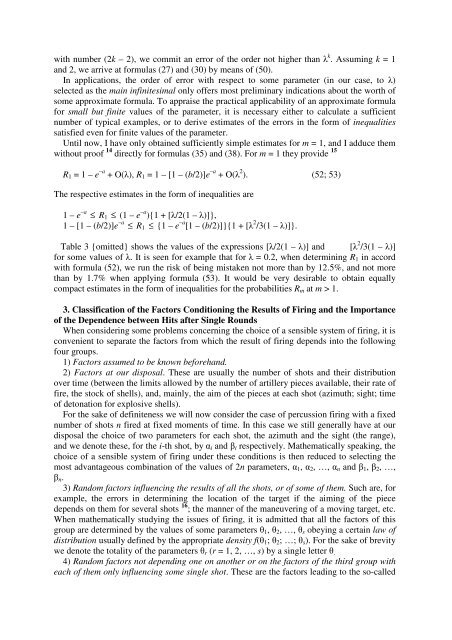kniga 7 - Probability and Statistics 1 - Sheynin, Oscar
kniga 7 - Probability and Statistics 1 - Sheynin, Oscar
kniga 7 - Probability and Statistics 1 - Sheynin, Oscar
You also want an ePaper? Increase the reach of your titles
YUMPU automatically turns print PDFs into web optimized ePapers that Google loves.
with number (2k – 2), we commit an error of the order not higher thank . Assuming k = 1<strong>and</strong> 2, we arrive at formulas (27) <strong>and</strong> (30) by means of (50).In applications, the order of error with respect to some parameter (in our case, to )selected as the main infinitesimal only offers most preliminary indications about the worth ofsome approximate formula. To appraise the practical applicability of an approximate formulafor small but finite values of the parameter, it is necessary either to calculate a sufficientnumber of typical examples, or to derive estimates of the errors in the form of inequalitiessatisfied even for finite values of the parameter.Until now, I have only obtained sufficiently simple estimates for m = 1, <strong>and</strong> I adduce themwithout proof 14 directly for formulas (35) <strong>and</strong> (38). For m = 1 they provide 15R 1 = 1 – e –a + O( ), R 1 = 1 – [1 – (b/2)]e –a + O( 2 ). (52; 53)The respective estimates in the form of inequalities are1 – e –a ≤ R 1 ≤ (1 – e –a ){1 + [ /2(1 – )]},1 – [1 – (b/2)]e –a ≤ R 1 ≤ {1 – e –a [1 – (b/2)]}{1 + [ 2 /3(1 – )]}.Table 3 {omitted} shows the values of the expressions [ /2(1 – )] <strong>and</strong> [ 2 /3(1 – )]for some values of . It is seen for example that for = 0.2, when determining R 1 in accordwith formula (52), we run the risk of being mistaken not more than by 12.5%, <strong>and</strong> not morethan by 1.7% when applying formula (53). It would be very desirable to obtain equallycompact estimates in the form of inequalities for the probabilities R m at m > 1.3. Classification of the Factors Conditioning the Results of Firing <strong>and</strong> the Importanceof the Dependence between Hits after Single RoundsWhen considering some problems concerning the choice of a sensible system of firing, it isconvenient to separate the factors from which the result of firing depends into the followingfour groups.1) Factors assumed to be known beforeh<strong>and</strong>.2) Factors at our disposal. These are usually the number of shots <strong>and</strong> their distributionover time (between the limits allowed by the number of artillery pieces available, their rate offire, the stock of shells), <strong>and</strong>, mainly, the aim of the pieces at each shot (azimuth; sight; timeof detonation for explosive shells).For the sake of definiteness we will now consider the case of percussion firing with a fixednumber of shots n fired at fixed moments of time. In this case we still generally have at ourdisposal the choice of two parameters for each shot, the azimuth <strong>and</strong> the sight (the range),<strong>and</strong> we denote these, for the i-th shot, by i <strong>and</strong> i respectively. Mathematically speaking, thechoice of a sensible system of firing under these conditions is then reduced to selecting themost advantageous combination of the values of 2n parameters, 1 , 2 , …, n <strong>and</strong> 1 , 2 , …, n .3) R<strong>and</strong>om factors influencing the results of all the shots, or of some of them. Such are, forexample, the errors in determining the location of the target if the aiming of the piecedepends on them for several shots 16 ; the manner of the maneuvering of a moving target, etc.When mathematically studying the issues of firing, it is admitted that all the factors of thisgroup are determined by the values of some parameters 1 , 2 , …, s obeying a certain law ofdistribution usually defined by the appropriate density f( 1 ; 2 ; …; s ). For the sake of brevitywe denote the totality of the parameters r (r = 1, 2, …, s) by a single letter .4) R<strong>and</strong>om factors not depending one on another or on the factors of the third group witheach of them only influencing some single shot. These are the factors leading to the so-called









